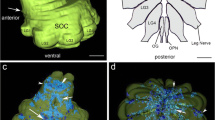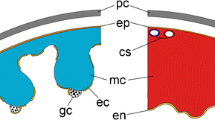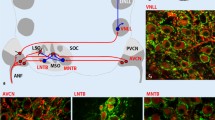Summary
The ultrastructure of the crayfish segmental giant (SG) neuron is described, and compared to other identified and unidentified crayfish neurons. The SG was specifically stained by intracellular injection of horseradish peroxidase and is divided into four regions of interest.
-
1.
In the dorsal region, finger-like dendrites of the SG make contact with the throughconducting giant fibres (GF). These contacts are physiologically defined rectifying electrical synapses. They are characterized by the presence of 30–95 nm agranular vesicles in the presynaptic GFs, some postsynaptic density in the SG, and a narrowing of the intermembrane cleft to ∼ 5nm. There is little evidence for connecting cytoplasmic bridges. Unidentified neurons make chemical input with either round or elliptical vesicle types onto SG bottlenecks close to the electrical synapses.
-
2.
Ventral to the GFs, dendritic profiles of the SG make three sorts of contact with unidentified neurons, (a) Regions of close membrane apposition (∼ 5nm) are presumed to be electrical output synapses, but there are no vesicles such as at the input synapses, and, again, little sign of connecting bridges. (b) Chemical input is received from unidentified presynaptic neurons containing either round or elliptical vesicles. These synapses are characterized by 30–75 nm presynaptic agranular vesicles, widened cleft (∼ 20 nm), granular cleft material and postsynaptic density. There is no sign of any presynaptic density. (c) Very occasional SG profiles containing vesicles and making output synapses to unidentified neurons occur.
-
3.
In the lateral neuropil at the edge of the ganglion the SG gives rise to a small tuft of very fine dendrites. These are nearly all laden with vesicles and ramify in a complex region of neuropil containing many small profiles which are also vesicle-laden.
-
4.
The SG axon diminishes in diameter as it progresses along its peripheral nerve root, and finally terminates at a blind ending near the base of the swimmerets. It is sheathed along its entire length, and there is no sign of vesicles within it. We conclude that the SG axon makes no peripheral output.
Similar content being viewed by others
References
Atwood, H. L. &Pomeranz, B. (1974) Crustacean motor neuron connections traced by backfilling for electron microscopy.Journal of Cell Biology 63, 329–34.
Atwood, H. L. &Pomeranz, B. (1977) Dendritic bottlenecks of crustacean motoneurons.Journal of Neurocytology 6, 251–68.
Atwood, H. L. &Sandeman, D. (1982) (eds)The Biology of the Crustacea, Vol. III,Neural Integration. New York: Academic Press.
Bennet, M. V. L. &Goodenough, D. A. (1978) Gap junctions, electrotonic coupling and intercellular communication.Neurosciences Research Program Bulletin 16, 377–486.
Bishop, G. A. &King, J. S. (1982) Intracellular horseradish peroxidase injections for tracing neural connections. InTracing Neural Connections with Horseradish Peroxidase, IBRO Handbook Series: Methods in the Neurosciences (edited byMesulam, M-M.), pp. 185–247. Chichester: John Wiley.
Bittner, G. D. (1981) Trophic interactions of CNS giant axons in crayfish.Comparative Biochemistry and Physiology 68A, 299–306.
Giaume, C. &Korn, H. (1983) Bidirectional transmission at the rectifying electrotonic synapse: a voltage-dependent process.Science 220, 84–7.
Hall, D. H., Spray, D. C. &Bennet, M. V. L. (1983) Gap junctions and septate-like junctions between neurons of the opisthobranch mollusc navanax inermis.Journal of Neurocytology 12, 831–6.
Hanna, R. B., Keeter, J. S. &Pappas, G. D. (1978) The fine structure of a rectifying electronic synapse.Journal of Cell Biology 79, 764–73.
Heitler, W. J. (1978) Coupled motoneurones are part of the crayfish swimmeret central oscillator.Nature 275, 231–4.
Heitler, W. J. (1981) Neural mechanisms of central pattern generation in the crayfish swimmeret system. InAdvances in Physiological Science, Vol. 23,Neurobiology of Invertebrates (edited bySalanki, J.), pp. 369–83. Oxford: Pergamon Press.
Heitler, W. J. &Darrig, S. (1986) The segmental giant neurone of the signal crayfish,Pacifastacus leniusculus, and its interactions with abdominal fast flexor and swimmeret motor-neurones.Journal of Experimental Biology (in press).
King, D. G. &Wyman, R. J. (1980) Anatomy of the giant fibre pathway in drosophila. I. Three thoracic components of the pathway.Journal of Neurocytology 9, 753–70.
Kramer, A. P., Krasne, F. B. &Wine, J. J. (1981) Interneurons between giant axons and motoneurons in crayfish escape circuitry.Journal of Neurophysiology 45, 550–73.
Krasne, F. &Stirling, C. A. (1972) Synapses of crayfish abdominal ganglia with special attention to afferent and efferent connections of the lateral giant fibres.Zeitschrift für Zellforschung und mikroskopische Anatomie 127, 526–44.
Nakajima, Y. &Reese, T. S. (1983) Inhibitory and excitatory synapses in crayfish stretch receptor organs studied with direct rapid-freezing and freeze-substitution.Journal of Comparative Neurology 213, 66–73.
Peracchia, C. (1973a) Low resistance junctions in crayfish. I. Two arrays of globules in junctional membranes.Journal of Cell Biology 57, 54–65.
Peracchia, C. (1973b) Low resistance junctions in crayfish. II. Structural details and further evidence for intercellular channels by freeze-fracture and negative staining.Journal of Cell Biology 57, 66–76.
Peracchia, C. &Delhunty, A. F. (1976) Low resistance junctions in crayfish: structural changes with functional uncoupling.Journal of Cell Biology 70, 419–39.
Peracchia, C. &Mittler, R. S. (1972) Fixation by means of glutaraldehyde-hydrogen peroxide reaction products.Journal of Cell Biology 53, 234–8.
Roberts, A., Krasne, F. B., Hagiwara, G., Wine, J. J. &Kramer, A. P. (1982) Segmental giant: evidence for a driver neuron interposed between command and motor neurons in the crayfish escape system.Journal of Neurophysiology 47, 761–81.
Skinner, K. (1985a) The structure of the fourth abdominal ganglion of the crayfishProcambarus clarki (Girard). I. Tracts in the ganglionic core.Journal of Comparative Neurology 234, 168–81.
Skinner, K. (1985b) The structure of the fourth abdominal ganglion of the crayfishProcambarus clarki (Girard). II. Synaptic neuropils.Journal of Comparative Neurology 234, 182–91.
Stirling, C. A. (1972) The ultrastructure of giant fibre and serial synapses in crayfish.Zeitschrift für Zellforschung und mikroskopische Anatomie 131, 31–45.
Watson, A. H. D. &Burrows, M. (1981) Input and output synapses on identified motor neurones of a locust revealed by the intra-cellular injection of horseradish peroxidase.Cell and Tissue Research 215, 325–32.
Wine, J. J. &Krasne, F. B. (1982) The cellular organization of the crayfish escape behaviour. InThe Biology of the Crustacea, Vol. III,Neural Integration (edited byAtwood, H. &Sandeman, D.), Chap. 15. New York: Academic Press.
Zampighi, G., Ramon, F. &Duran, W. (1978) Fine structure of the electrotonic synapse of the lateral giant axons in a crayfish (Procambarus clarkii).Tissue and Cell 10, 413–26.
Zucker, R. S. (1972) Crayfish escape behaviour and central synapses. I. Neural circuit exciting lateral giant fiber.Journal of Neurophysiology 35, 621–37.
Author information
Authors and Affiliations
Rights and permissions
About this article
Cite this article
Heitler, W.J., Cobb, J.L.S. & Fraser, K. Ultrastructure of the segmental giant neuron of crayfish. J Neurocytol 14, 921–941 (1985). https://doi.org/10.1007/BF01224805
Received:
Revised:
Accepted:
Issue Date:
DOI: https://doi.org/10.1007/BF01224805




